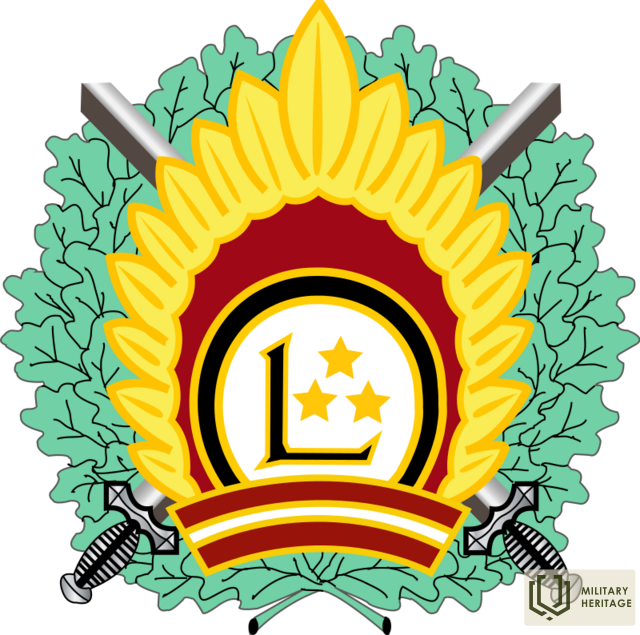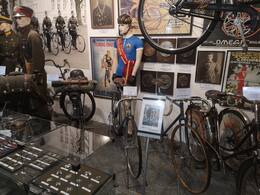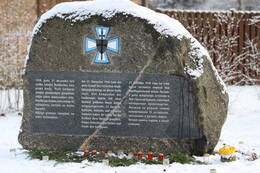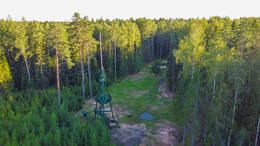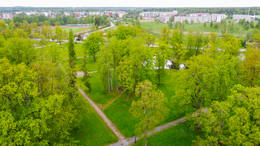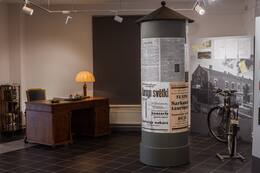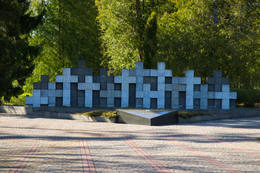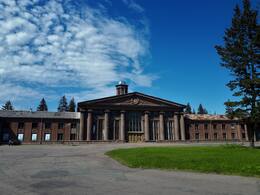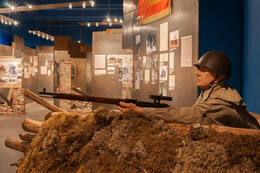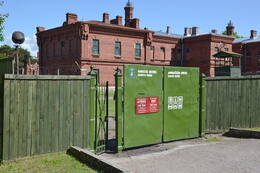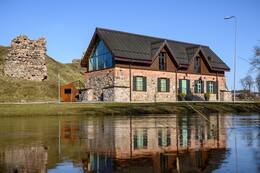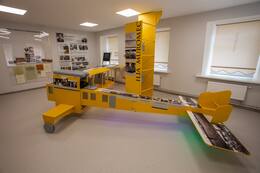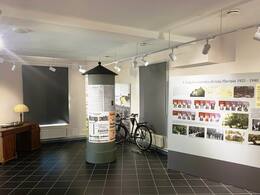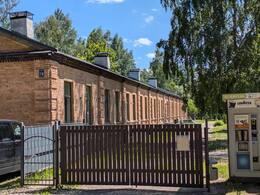Latvijos armija
I Nepriklausomybės karai, Baltijos šalių nepriklausomybė, II Antrasis pasaulinis karas
1919 m. sausio 5 d. buvo suformuotas pirmasis didesnis nacionalinis karinis dalinys – Atskirasis Latvijos batalionas, vadovaujamas pulkininko leitenanto Oskaro Kalpako. Šis dalinys, kovo mėnesį reorganizuotas į brigadą, kartu su Estijoje organizuota Šiaurės Latvijos brigada, kuriai vadovavo pulkininkas Jorgis Zemitāns, sudarė Latvijos armiją. Naujai suformuota armija augo ir grūdinosi mūšiuose su bermontininkais prie Rygos ir Kurše, taip pat mūšiuose su bolševikais Latgalos fronte.
Praėjus savaitei po Pirmojo pasaulinio karo pabaigos ir Kompjeno paliaubų sudarymo 1918 m. lapkričio 11 d., buvo paskelbta apie nepriklausomos Latvijos valstybės įkūrimą. Naujoji laikinoji vyriausybė tikėjosi, kad jai pavyks apsieiti be reguliariosios armijos formavimo, nes ji neketino nieko pulti. 1918 m. lapkričio 13 d. Sovietų Rusija anuliavo Bresto taikos sutartį, kuria ji atsisakė Baltijos teritorijų Vokietijos naudai, ir pradėjo puolimą į Vakarus. Viltys, kad Vokietijos armija įvykdys savo įsipareigojimą ginti Latviją nuo bolševikų invazijos, nepasiteisino.
Tuo tarpu Rygoje formavosi Latvijos Respublikos Laikinajai vyriausybei ištikimi daliniai. 1919 m. pavasarį Latvijos ginkluotąsias pajėgas sudarė Landesveras (Baltijos vokiečių nacionalinė gvardija), Šiaurės Latvijos brigada ir Pietų Latvijos brigada. Abi šias brigadas 1919 m. liepos 10 d. sujungė generolas Dāvis Sīmansonsas, tapęs pirmuoju Latvijos armijos vyriausiuoju vadu. Ši diena laikoma Latvijos armijos įkūrimo diena.
1919 m. Latvijos kariuomenė buvo sparčiai perginkluota ir plėtojama, ginkluotė ir įranga buvo gauta iš Anglijos, Lenkijos ir kitų šalių. 1920 m. pradžioje Latvijos ginkluotosiose pajėgose tarnavo apie 52 000 kareivių. Nepriklausomybės karas baigėsi 1920 m. rugpjūčio 11 d., kai buvo pasirašyta taikos sutartis su Sovietų Rusija. Iškart po Nepriklausomybės karo Latvijos kariuomenė pradėjo pereiti į taikos meto būseną. Latvijos armiją sudarė keturios pėstininkų divizijos su trimis pėstininkų pulkais ir po artilerijos pulką kiekviename. Pėstininkų pulkai buvo sunumeruoti ir pavadinti Latvijos miestų vardais. Latvijos kariuomenė taip pat turėjo karinį jūrų laivyną, kurį sudarė flagmaninis laivas „Virsaitis“, povandeninių laivų divizija su dviem povandeniniais laivais „Ronis“ ir „Spīdola“, taip pat minų divizija su dviem minų traleriais „Imanta“ ir „Viesturs“ bei keliais pagalbiniais laivais.
Kariuomenė buvo formuojama pagal visuotinę karo prievolę, kuriai privalėjo paklūsti visi Latvijos piliečiai. Iki 1931 m. tarnybos laikotarpis buvo 18 mėnesių, vėliau pėstininkams jis buvo sutrumpintas iki 12 mėnesių, kitoms ginkluotosioms pajėgoms – iki 15 mėnesių. Kariuomenei ir laivynui vadovavo Karo ministerija. Karo ministras buvo pavaldus armijos vadui, kuris buvo atsakingas už kariuomenės mokymą ir parengimą.
1940 m. birželio 1 d. Latvijos armijoje buvo 30 843 vyrai. 1940 m. birželio 17 d., per Antrąjį pasaulinį karą, Sovietų Sąjunga perėmė visos Latvijos ir Estijos kontrolę. Latvijos armija buvo palaipsniui išformuota, Latvijos kareiviai išleisti į pensiją, suimti ir deportuoti. 1940 m. rugsėjo 27 d. buvo panaikintas Latvijos karo ministro pareigybė, o 1940 m. spalio 9 d. – Latvijos liaudies armijos vado pareigybė.
1989 m. birželio 17 d. Rygoje, Latvijos valstybinio universiteto Didžiojoje salėje, įvyko Latvijos šaulių sąjungos steigiamoji konferencija. Po jos per kelias savaites prie Latvijos šaulių sąjungos prisijungė daugiau nei 500 buvusių karių. Rudenį buvo suformuoti skyriai ir grupės Jelgavoje, Tukume, Liepojoje, Bauskėje, Balvuose, Lyvanuose, Maskvoje ir kitur. Pradėtas aktyvus darbas kuriant ir plėtojant įstatymus, reglamentus ir įvairius dokumentus, kurie būtų reikalingi kariuomenės sukūrimui ir egzistavimui.
1991 m. rugsėjo 10 d. buvo priimtas Privalomosios karinės tarnybos įstatymas. Pagal šį įstatymą visi Latvijos piliečiai – vyrai, nuo 19 iki 50 metų amžiaus, privalo atlikti privalomąją karinę tarnybą. Netrukus po šio įstatymo priėmimo, lapkričio 11 d., Brolių kapinėse, buvo duota pirmoji kario priesaika nuo Latvijos nepriklausomybės atkūrimo.
Daugiau informacijos šaltinių
1. 100 įvykių Latvijos istorijoje. Žmonės ir procesai 1918–2018 m. AS „Latvijas Mediji“, 2018 m.
2. Sielų pūga. Skaitmeninis muziejus. Prieinama: https://www.dveseluputenis.lv/lv/laika-skala/notikums/105/sarkanas-armijas-iebrukums-latvija/ [žiūrėta: 2021-05-08].
3. Nacionalinių ginkluotųjų pajėgų svetainė. Prieiga per internetą: https://www.mil.lv/lv/par-mums/vesture [žiūrėta 202-05-08]
Susijusios vietos
Karinių motociklų ekspozicija Saulkrastų dviračių muziejuje
Dviračių muziejus yra Saulkrastuose, netoli A1 greitkelio ir Pabaži geležinkelio stoties, šalia Baltosios kopos. Muziejaus kolekciją sudaro techniškai įdomiausi dviračių raidos istorijos pavyzdžiai Latvijoje. Tai didžiausia dviračių kolekcija Baltijos šalyse, kurioje yra apie 60 Latvijoje pagamintų ir naudotų dviračių, įskaitant armijos tipo dviračius. XX amžiaus pradžioje daugelis armijų pradėjo plačiai naudotis dviračių prieinamumu ir privalumais. Dėl jų mobilumo buvo suformuoti specialūs dviračių daliniai. Dviračių daliniai galėjo lengviau rinkti žvalgybos informaciją ir pradėti netikėtus išpuolius, be to, jie buvo mobilesni nei įprasti pėstininkai, kai reikėjo vykdyti operacijas plačioje teritorijoje. Po Pirmojo pasaulinio karo Latvijos armija taip pat turėjo dviračių dalinių, kurie naudojo Latvijoje pagamintus armijos dviračius. Kiekvienas tokiame dviračių dalinyje tarnavęs kareivis turėjo atitikti griežtus reikalavimus. Būtina gera ištvermė, regėjimas ir klausa, taip pat sveika širdis ir plaučiai. Jie negalėjo sverti mažiau nei 80 kg, o jų ūgis turėjo būti 165–180 cm. Latvijos armijoje buvo laikomasi standarto, kad gerai apmokytas dviratininkas per dieną turėtų įveikti 80–100 km, o priverstinėmis sąlygomis – iki 150 km. Žiemą, kai nebuvo galima naudoti dviračių, buvo naudojamos slidės. Dviračių būrio kareivis turėjo sugebėti per dieną nučiuožti 50–60 km. Daugelis dviračių būrių kareivių vėliau tapo profesionaliais sportininkais.
Kasmet sulaukiame apie 5000 lankytojų.
Paminklas pirmajam mūšiui už Latvijos nepriklausomybę
Adresas: Inčukalns, Atmodas g. 2.
2016 m. liepos 3 d. buvo atidengtas paminklas pirmajam mūšiui už Latvijos nepriklausomybę, skirtas Latvijos landesverui (Die Lettländische Landeswehr), kuriame vietos baltų vokiečiai, rusai ir latviai, tuo metu buvę abiejų pusių daliniuose, gynė naujai įkurtą valstybę nuo bolševikų Raudonosios Armijos. Brolių kapų komiteto pirmininkas Eiženas Upmanis tuo metu padarė išvadą, kad tai galėtų būti pirmasis paminklas jungtinėms Latvijos ir Baltijos vokiečių pajėgoms mūšio memorialuose už kapinių ribų. Tuo metu Latvijos landesvero latvių dalinių vadu buvo paskirtas pulkininkas leitenantas Oskaras Kalpaksas, iš kurio dalinių Laisvės kovų metu išaugo ir susiformavo vėlesnė Latvijos armija.
1918 m. visa dabartinės Latvijos teritorija pateko į Vokietijos imperijos ir jos kariuomenės rankas. Tačiau 1918 m. vasaros pabaigoje ir rudenį padėtis ėmė sparčiai keistis prieš Vokietiją ir tapo aišku, kad tik laiko klausimas, kada Vokietija bus priversta pripažinti pralaimėjimą Pirmajame pasauliniame kare. Rusijos imperija, kurios dalimi Latvija buvo iki Pirmojo pasaulinio karo, nustojo egzistuoti anksčiau, po 1917 m. vasario ir spalio revoliucijų. 1918 m. lapkričio 18 d. buvo paskelbta Latvijos Respublika. Vokietijos kariuomenė, kuri po 1918 m. lapkričio 11 d. paliaubų su Antantės valstybėmis buvo dislokuota Latvijos teritorijoje, nebebuvo motyvuota tolesniems karo veiksmams, ir dauguma jos kareivių tiesiog norėjo grįžti į tėvynę.
Tokiomis aplinkybėmis buvo akivaizdu, kad Latvijos gynyba pirmiausia priklausė nuo pačių Latvijos gyventojų suformuotos nacionalinės gvardijos. Iš pradžių, dėl savo išsilavinimo ir santykinai didesnio gebėjimo savarankiškai organizuotis, didžiausią iniciatyvą formuojant tokią nacionalinę gvardiją rodė Latvijoje gyvenantys Baltijos vokiečiai. Į nacionalinę gvardiją įstojo ir Rusijos kareiviai. Siekdama užtikrinti nacionalinės gvardijos aprūpinimą uniformomis, ginklais ir kitais reikalingais ištekliais, Latvijos laikinoji vyriausybė 1918 m. gruodžio 7 d. sudarė susitarimą su Vokietijos atstovu Augustu Vinnigu, numatantį nacionalinės gvardijos aprūpinimą iš Latvijos teritorijoje esančių Vokietijos armijos rezervų. Šiame susitarime, be kita ko, buvo nurodyta, kad ši nacionalinė gvardija, oficialiai vadinama „Latvijas zemessardze“ arba vokiškai „die Lettländische Landeswehr“, bus Latvijos Respublikos ginkluotosios pajėgos.
Latvijos nacionalinė gvardija susidūrė su dviem Latvijos raudonųjų šaulių pulkais (t. y. maždaug 2000–3000 karių), kurie anksčiau buvo patyrę Pirmajame pasauliniame kare ir Rusijos pilietiniame kare. Nepaisant Raudonosios armijos patirties ir skaitinės persvaros, Latvijos nacionalinė gvardija dvi dienas laikė Inčukalną įnirtingose kovose, kol galiausiai 1919 m. sausio 1 d. vakarą, norėdama išvengti apsupties, buvo priversta trauktis, praradusi 43 žuvusius ir kelis sužeistuosius, kurių dauguma buvo bolševikų sučiupti, kur žuvo arba mirė nuo bado ar ligų.
Autorius: Artis Buks. Medžiaga: lauko akmuo. Paminklas pagamintas iš didelio monolitinio akmens, rasto Ruļļuose netoli Jelgavos.
Latvijos kariuomenės vasaros stovykla Litenėje
Latvijos armijos vasaros stovykla Litenėje įsikūrusi miške, Litenės valsčiuje, netoli Pededzės upės. Litenės stovyklos ištakos siekia 1935 m., kai buvo pradėtas Latvijos armijos Latgalos divizijos vasaros stovyklos komplekso statyba. Nuo gegužės iki rudens Litenėje keli tūkstančiai kareivių mokėsi kovos taktikos ir šaudymo įgūdžių. 1941 m. vasarą Latvijos armijos karininkus Litenės armijos vasaros stovykloje suėmė Raudonosios armijos ir NKVD kariuomenės daliniai. Keletas karininkų buvo sušaudyti vietoje, kiti ištremti į Sibirą. 1941 m. birželio 14 d. mažiausiai 430 karininkų buvo suimti ir ištremti į Sibirą Litenės ir Ostroviečių stovyklose, esančiose maždaug už 10 kilometrų nuo Litenės. Vienintelis išlikęs istorinis stovyklos pastatas yra maisto sandėlis. Iš kitų pastatų išlikę tik pamatai. Yra apžvalgos aikštelė su Latvijos vėliava, suolai ir gerai prižiūrima laužavietė. Gynybos ministerijos ir Nacionalinių ginkluotųjų pajėgų remiant, buvo įrengta demilitarizuota patranka. Pastatyti informaciniai stendai. Su Litenės stovyklos įvykiais taip pat susijęs Skausmo sienos memorialas Litenės kapinėse. Latvijos armijos „YouTube“ kanale yra vaizdo įrašas pavadinimu „Litene, Latvijos armijos Katynė“.
Latvijos karinės aviacijos oro uostas
Įsikūręs Vecgulbenės dvaro teritorijoje – istoriniame centre.
Tarpukariu Gulbenėje buvo įsikūręs Latvijos armijos garnizonas, kuriame buvo dislokuotas 7-asis Siguldos pėstininkų pulko batalionas. Ketvirtojo dešimtmečio viduryje pradėta kurti karinė aviacijos bazė, nes sėkmingam karinės aviacijos veikimui net taikos metu turi būti užtikrintas platus aerodromų tinklas. Aerodromai ypač svarbūs tose vietose, kur įkurtos svarbios geležinkelio ir kelių sankryžos. 1935 m. lapkričio 11 d. čia pradėtas karinio aerodromo statymas. 1937 m. Gulbenėje buvo dislokuotas naujai suformuotas Aviacijos pulko dalinys, kuris tapo 6-uoju Latgalos divizijos žvalgybos eskadrile, padidindamas armijos dalinių skaičių prie rytinės Latvijos sienos.
Matosi oranžerijos pastatas.
Paroda „Latvijos armija Pliavinėse XX amžiuje“.
Adresas: Odzienas g. 2, Pļavinės.
Eksponuojama nuolatinė ekspozicija „Latvijos armija Pliavinėse XX amžiuje“.
Pastatas Pliavinėse, Odzienos gatvėje 2, turi ilgą istoriją – nuo tada, kai „Stukmaņi“ didmenininkas „Hugo Apeltofts“ pradėjo jame aktyvią ūkinę veiklą ir taip prisidėjo prie Pliavinių miesto plėtros, iki to momento, kai Nepriklausomybės karo metu čia buvo įkurtas Latvijos Rytų fronto štabas. 1919 m. būtent iš Pliavinių buvo vadovaujamos Latvijos armijos dalinių operacijos prieš Raudonąją armiją Latgaloje.
1934 m. prie šių namų buvo atidengta memorialinė lenta su užrašu: „1919 m. šiuose namuose buvo įsikūręs Rytų fronto štabas, o čia generolas Janis Balodis perėmė vyriausiąją Latvijos nacionalinės armijos vadovybę.“ Sovietų valdžia ją 1940 m. pašalino ir sunaikino, tačiau 1990 m. birželio 16 d., padedant Latvijos nacionalinės išlaisvinimo armijos Pliavinės skyriui, ji buvo atstatyta.
Dabar šalia buvusio štabo pastato stovi memorialinė stela, skirta 15 Lačplėsio Karo ordino riterių, gimusių Pliavinos krašte, o patalpose sukurta paroda „Latvijos armija Pliavinoje XX amžiuje“, kurioje pasakojama apie Laisvės kovų įvykius, Latvijos armijos 3-iosios Latgalos divizijos štabo veiklą Pliavinoje, taip pat galima susipažinti su Lačplėsio Karo ordino riterių gyvenimo istorijomis.
Netoli parodų pastato yra Latgalos divizijos štabo pastatas, kurį 1913 m. kaip „Stukmanu“ likerio fabriką pastatė grafas Teodoras Medemas. 1919 m. jį perėmė P. Stučkos režimas, kuriame taip pat buvo įkurtas kalėjimas. Išvijus bolševikus, 1925 m. pastatą perėmė Latvijos armija, kurioje buvo įsikūręs Latgalos divizijos štabas. Šiame pastate savo karinę karjerą praleido 10 Latvijos armijos generolų ir kitų karininkų. 1940 m. pastatą perėmė Raudonoji armija. Pokario metais jame buvo įsikūrusi mokykla, taip pat savivaldybė. Apie 1970 m. pastatą pradėjo naudoti gamybos susivienijimas „Rīgas Apērbs“.
Parodą būtina apžiūrėti iš anksto telefonu 28442692.
Memorialas „Skausmo siena“
Litenės kapinėse randama meno kūrinių.
2001 m. birželio 14 d. Litenės kapinėse buvo atidengtas architektų Dinos Grūbės, Benitos ir Dainio Bērzinių, akmenkalių Ivaro Feldbergo ir Sandro Skribnovskio sukurtas memorialas „Skausmo siena“. Jis simbolizuoja 1941 m. žuvusių karių poilsio vietą. 1988 m. spalį buvusios Latvijos armijos vasaros stovyklos teritorijoje Sita siloje, Litenės parapijoje, rasti 11 karininkų, kuriuos 1941 m. birželį nužudė sovietų armija, pelenai. Nors jų tapatybės nustatyti nepavyko, 1989 m. gruodžio 2 d., po pašventinimo pamaldose Gulbenės evangelikų liuteronų bažnyčioje, jie buvo iškilmingai perlaidoti Litenės kapinėse.
11 baltų kryžių, atminimo lenta ir informaciniai stendai.
Pagalvės oro uostas
Įsikūręs Rygoje, Pārdaugavoje, Spilvės pievose netoli Iļģuciems.
Spilvė karinio paveldo istorijoje garsėja grandioziniu Spilvės mūšiu XVIII a. ir Spilvės aerodromu. Nuo XX a. ji buvo naudojama lėktuvams bandyti, tačiau Pirmojo pasaulinio karo metu tapo Latvijos aviacijos istorijos liudininku.
Pirmojo pasaulinio karo metu Spilvės pievas Rusijos armijos oro pajėgos naudojo kovai su Vokietijos armija. Sukūrus Latviją, aerodromas tapo svarbiausia šalies oro pajėgų baze ir pilotų mokymo aikštele. Ankstesni aerodromo pavadinimai buvo „Spilvės oro uostas“ arba „Rygos oro uostas“, vėliau „Rygos centrinis oro uostas“. Tai buvo pagrindinis Latvijos oro uostas iki „Rygos“ oro uosto atidarymo 1975 m.
Galbūt Spilvės aerodromas netoli Rygos ir svajonė siekti žvaigždžių prisidėjo prie įspūdingų daugelio Latvijos pilotų pasiekimų. Tačiau galbūt Latvijos aviacijos pradžia yra daug senesnė ir siekia Priekulę, kur latvių kalvis Zviedris savadarbiu prietaisu atliko skrydį iš bažnyčios bokšto.
Šiandien Spilvės aerodromas veikia vis dar. Galima pamatyti 1954 m. pastatytą oro uosto pastatą, kuris įkūnija sovietinį klasicizmą arba „Stalino imperijos“ stilių.
Šaltiniai:
Irbītis, K. Latvijos aviacija ir jos pradininkai. Ryga: Zinātne, 2004 m.
Brūvelis, E. Latvijos aviacijos istorija: 1919-1940. Ryga: Zinātne, 2003 m.
Oficiali valstybinės agentūros „Civilinės aviacijos agentūra“ svetainė. Prieiga per internetą: https://www.caa.gov.lv/lv/latvijas-aviacijas-vesture-isuma [žiūrėta 2021-02-22].
Latvijos karo muziejus
Latvijos karo muziejus yra įsikūręs senamiestyje, netoli Laisvės paminklo, istoriniame gynybos pastate, vadinamame „Parako bokštu“. Muziejuje yra 11 eksponatų. Čia eksponuojami įvairūs ginklai, dokumentai, uniformos, apdovanojimai, ženkleliai ir kiti daiktai, pasakojantys apie kasdienį kareivio gyvenimą kare. Latvijos karo muziejus yra vienas seniausių muziejų Latvijoje. Jo ištakos siekia Pirmąjį pasaulinį karą. Muziejaus kolekciją daugiausia sudarė asmeniniai kareivių daiktai arba mūšio laukuose rasti daiktai. Latvijai atgavus nepriklausomybę, pagrindinis muziejaus tikslas tapo sukurti ekspoziciją apie Latvijos karo istoriją ir aktyvų gyventojų vaidmenį saugant savo žemę. 1937 m. muziejus buvo išplėstas ir techniškai buvo vienas moderniausių tuo metu Europoje. Parako bokštas buvo vienas iš Rygos įtvirtinimų bokštų. Kai kurie įrodymai siekia 1330 m., kai jis buvo minimas kaip „Smėlio bokštas“. Bokštas buvo sugriautas 1621 m., kai Rygą apgulė Švedijos armija. Tačiau 1650 m. buvo pastatytas naujas bokštas parakui ir ginklams laikyti. Nugriovus miesto įtvirtinimus, Parako bokštas išlieka vienu svarbiausių Rygos gynybos sistemos įrodymų.
Laisvosios valstybės brangenybių namai
Nepriklausomos valstybės palikimą saugantys namai yra šalia Rėzeknės pilies griuvėsių.
Išskirtinėje ekspozicijoje pristatoma keli šimtai istorinių eksponatų iš Latvijos ir užsienio privačių kolekcijų, apimančių 1918–1940 m. laikotarpį, bei skirtingus Latgalos ir Rėzeknės istorijos puslapius. Supažindinama su Pirmosios nepriklausomos Latvijos valstybės karinių ir civilinių apdovanojimų istorija, įvairių valstybinių ir visuomeninių organizacijų veikla, vykusia nuo Latvijos nepriklausomybės karo iki Antrojo pasaulinio karo.
Tai didžiausia Latvijoje kolekcija, pristatanti nepriklausomos valstybės karinius ir civilinius apdovanojimus bei skiriamuosius ženklus.
Antrajame aukšte įrengta keičiamų parodų salė, kurioje bent kartą per metus surengiama nauja paroda. Lankytojai jau turėjo galimybę pamatyti išskirtinę porceliano dirbinių kolekciją, prabangius laikrodžius iš Prancūzijos ir įvairius Latgalos peizažus vaizduojančius paveikslus.
Preilių istorijos ir taikomosios dailės muziejaus ekspozicija „Jazepas Baško – vežėjas oru“ (Jāzeps Baško – gaisa fūrmanis)
Ekspozicija „Jazepas Baško – vežėjas oru“ skirta lakūnui, eskadrilės „Iļja Muromec“ vadui ir Latvijos karinių oro pajėgų organizatoriui, generolui Jazepo Baško, minint jo 125-ąsias gimimo metines bei Pirmojo pasaulinio karo 100-metį.
Muziejaus fonduose saugoma ekspozicija – tai ir dizaino objektas: šešis kartus sumažintas lėktuvo „Ilja Muromec“ maketas, su kuriuo pateikiama informacija tekstų ir vaizdų pavidalu. Paroda papildyta Latvijos karo muziejaus eksponatais ir nauja archyvine medžiaga, gauta iš Latvijos valstybinio istorijos archyvo, Spilvės aviacijos muziejaus ir privačių asmenų archyvų.
Jazepas Baško pelnytai laikomas vienu labiausiai apdovanotų latvių lakūnų ir vienu iš pasaulinės aviacijos pradininkų. Su lėktuvu „Ilja Muromec“ jis pasiekė keturis pasaulio aviacijos rekordus, o jo pavardė įrašyta į Louis Blériot Garbės knygą Paryžiuje – geriausių pasaulio lakūnų sąrašą.
Jazepas Baško buvo apdovanotas visais tuometės carinės Rusijos ordinais, taip pat Latvijoje – Trijų žvaigždžių 3-iojo laipsnio ordinu, Viesturo 2-ojo laipsnio ordinu, Gynėjų nuopelnų kryžiumi bei aukščiausiais Čekoslovakijos, Estijos, Suomijos ir Lenkijos apdovanojimais.
Jis tarnavo carinės Rusijos kariuomenėje, bolševikų Raudonojoje armijoje, o nuo 1921 m. – Latvijos kariuomenėje. Po Latvijos okupacijos buvo atleistas iš tarnybos.
Ekspozicija „Latvijos kariuomenė Pliaviniose XX a.“
Ekzpozicija, skirta Latvijos kariuomenės kūrimosi istorijai, yra Pliaviniose. Pastatas, kuriame ji įrengta, turi ilgą istoriją. Kai buvo pastatyta Stukmanių (dabar Pliavinių) geležinkelio stotis, visoje apylinkėje buvo pradėti statyti namai. Vienas jų, pastatytas 1900 m., buvo pirklio Hugo Apeltofto namas. Iš pradžių statytas kaip pirklių namas, vėliau tapo vieta, kur pradėta formuoti Latvijos kariuomenė.
1919 m. liepą, vykstant Nepriklausomybės karams, čia įsikūrė Latvijos rytų fronto štabas. 1934 m. birželio 17 d. minint šį istorinį įvykį, ant pastato buvo atidengta atminimo lenta su įrašu: „Šiame name 1919 m. buvo įsikūręs Rytų fronto kariuomenės vado štabas, ir iš čia Janis Baluodis vadovavo kaip Latvijos nacionalinės kariuomenės vadas.“ 1990 m. birželio 16 d. atminimo lenta buvo restauruota. 2019 m. birželio 10 d. priešais buvusio štabo pastatą buvo pastatyta atminimo stela, skirta Pliavinių apylinkėje gimusiems kovotojams, apdovanotiems Lačplėsio karo ordinu.
Ekspozicijoje įrengti informaciniai stendai su istorinėmis nuotraukomis, žemėlapiais ir informacija apie Latvijos Rytų fronto štabo formavimąsi.
Latgalos artilerijos pulko armijos kareivinės
Latgalos artilerijos pulko armijos kareivinės buvo pastatytos kaip trijų aukštų modernus pastatas pagal architekto Vernerio Vitando projektą 1931 m. Šis monolitinis gelžbetoninis pastatas buvo vienas pirmųjų Latvijoje. Jie išliko iki šių dienų, esantys Krustpilio dvaro teritorijoje, šalia pilies parko. Šiandien išlikęs trijų aukštų pastatas yra nevaldomas Jekabpilio savivaldybės turtas. Langų angos be langų, patekti į pastatą neįmanoma, pastatą galima apžiūrėti iš išorės. Savivaldybė atliko stogo keitimo darbus. Ateityje planuojama pastatą renovuoti, jame įkuriant įvairias organizacijas, ir perduoti jį verslininkams naudoti.
Latgalos artilerijos pulką sudarė du divizionai, kiekvienas divizionas turėjo dvi patrankas ir vieną haubicų bateriją, iš viso pulke buvo 16 patrankų ir aštuonios haubicos. Likę pulkui priskirti artilerijos daliniai buvo laikomi konservuotuose sandėliuose ir buvo skirti trečiosios divizijos formavimui karo atveju.
Rygos garnizono armijos palapinių stovykla
Dabar čia auga krūmynai ir tankmės, tačiau praėjusio amžiaus ketvirtajame dešimtmetyje čia buvo įsikūrusi Rygos garnizono armijos vasaros stovykla. Kai kuriose vietose vis dar galima pamatyti tai, kas atrodo kaip stačiakampiai pylimai. Šiose vietose stovėjo kareivių palapinės, išdėstytos keturiomis ilgomis eilėmis, o viduryje – mažos gatvelės. Eilių galuose stovėjo garnizono dalinių logotipai – jie buvo lieti iš betono, o papuošalai ir užrašai – iš mažų, spalvingų akmenėlių. Pylimai aplink palapines buvo reikalingi ne tik drėgmei sulaikyti, bet ir kariniams tikslams. Jei į Mangaļsalą įžengdavo desantininkai, jie būdavo naudojami kaip apkasai, kurių priedangoje teritorija būdavo saugoma nuo priešo. Nors čia vyko tikros karinės pratybos, ore tvyrojo romantiška idilė, kuri matoma ir to meto nuotraukose. Jaunimas žaidė tinklinį. Karininkų namelių kiemuose buvo sutvarkytos pavėsinės ir gėlynai. Savaitgaliais kareivius lankydavo jų artimieji, atnešdami krepšius braškių ir šviežios duonos. Didžioji dalis maisto buvo valgoma lauke, prie stalų, gryname ore.
Armijos miestelis
Šiame rajone 1920-ųjų pabaigoje ir 1930-ųjų pradžioje Latvijos armija pastatė armijos stovyklą karininkams ir kareiviams, dirbusiems Mangalsaloje. Vėliau stovykla kartu su Mangalsalos karine baze tapo Sovietų Sąjungos nuosavybe. Čia gyveno civiliai gyventojai be jokio statuso, tačiau vėliau buvo įrengti socialiniai butai mažas pajamas gaunantiems žmonėms. Dešinėje pusėje buvo futbolo aikštė ir maži sodai, tačiau laikui bėgant jie virto pievomis ir pelkėmis. Vėliau čia atsirado privatūs namai ir automobilių servisas. Iki 1960-ųjų Mangalsala visai nebuvo Rygos, o Mangalos parapijos dalis. Tuo metu žmonės čia vertėsi žvejyba arba dirbo armijos bazėje, nes žemės ūkis buvo praktiškai neįmanomas – dirbamos žemės plotas Mangalsaloje tesiekia 3,8 %. Kadaise per stovyklą palei Mangalsalos gatvę ėjo siaurasis geležinkelis, tačiau pati gatvė buvo asfaltuota. Dabar danga paslėpta po asfalto sluoksniu. Kelio gale yra uosto teritorija ir buvusi karinė prieplauka. Kadaise ten buvo švartuojami kariuomenės laivai, o tarp jų buvo nutiesti pėsčiųjų tiltai.
Galima pamatyti iš išorės, einant Mangaļsalo gatve.
Susijusi istorija
Apie pirmąjį Latvijos armijos vyriausiąjį vadą Dāvidą Sīmansoną
Knygos „Latvijos armijos vadai“ esė įtikina, kad istorijai didelę įtaką daro konkretūs asmenys. Nors svarbiausių istorinių įvykių epicentre jie buvo trumpą laiką, tikri Latvijos patriotai, turėdami didelę karinę patirtį, sugebėjo daug nuveikti formuojant ir stiprinant Latvijos kariuomenę bei istorinių įvykių lūžio taškuose.
Ši istorija yra apie pirmąjį Latvijos armijos vyriausiąjį vadą Dāvidą Sīmansoną (1859–1933).
Latvijos kariuomenės generolo, dukart Lāčplėsio karo ordino kavalieriaus Pēterio Radzinio atminimui.
Generolas Pēteris Radziņš gimė Lugažių valsčiuje, Valkos rajone, paprasto ūkininko šeimoje, kur išmoko dirbti lauko darbus. Jis buvo labai protingas jaunuolis, baigęs mokyklą pasirinko karą ir taip pradėjo savo karinę karjerą, gelbėdamas Latviją nuo Bermonto kariuomenės. P. Radziņš buvo vienas iškiliausių Latvijos armijos karininkų, apdovanotas daugybe Latvijos ir užsienio ordinų bei atminimo ženklų.
Kariuomenės buvimas Mangalsaloje
Atsiminimuose ryškūs įspūdžiai apie Latvijos kariuomenės buvimą Mangalsaloje. Aprašomi fortai, taip pat sapierų pastatytas gelžbetoninis įtvirtinimas. Atsiminimuose aprašomas karių kasdienis gyvenimas, gyvenimo ritmas ir iliustruojama Mangalsalos aplinka. Mangalsalos ir Latvijos armijos karių vizitas.
Karo muziejaus kūrimo pradžios prisiminimai
Pasakotojas aprašo aplinkybes, kuriomis buvo įkurtas Karo muziejus. Paminėtos problemos ir kolekcijų kūrimo darbai.
Jungtinės aviacijos diena – tikra nacionalinė šventė
Pasakotojas aprašo vieną populiariausių ir gausiausiai lankomų Latvijos renginių – Aviacijos festivalį Spilvėje. Jis apibūdina festivalio eigą ir mastą. Jis pabrėžia aviacijos populiarumą Latvijoje.
Apie Sidabrinio kalno atidarymo ceremoniją
Ištrauka iš prisiminimų istorijos iš generolo Jāņo Baložo kalbos Sudrabkalninio paminklo atidengimo dieną. Visas tekstas yra atidarymo renginio atpasakojimas, prezidento Kārlio Ulmanio ir generolo Jāņo Baložo kalbos. Prisiminimai pasirinkti, nes juose vaizdingai matyti Sudrabkalnino apylinkėse kovojančios Latvijos kariuomenės būklė.
Apie Daugavgryvos tvirtovę
Pasakotojas aprašo įvykį Daugavgryvos tvirtovėje Pirmojo pasaulinio karo metu, kai ją subombardavo vokiečių armijos dirižablis. Tvirtovė buvo vienas iš strateginių objektų, išlaikiusių savo svarbą iki Antrojo pasaulinio karo pabaigos.




